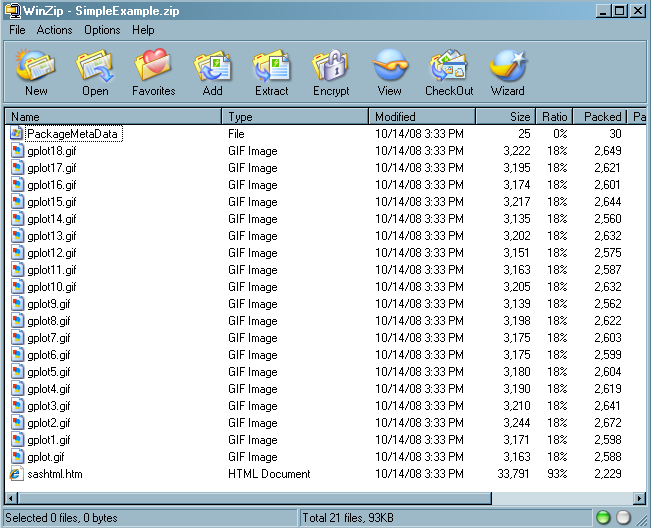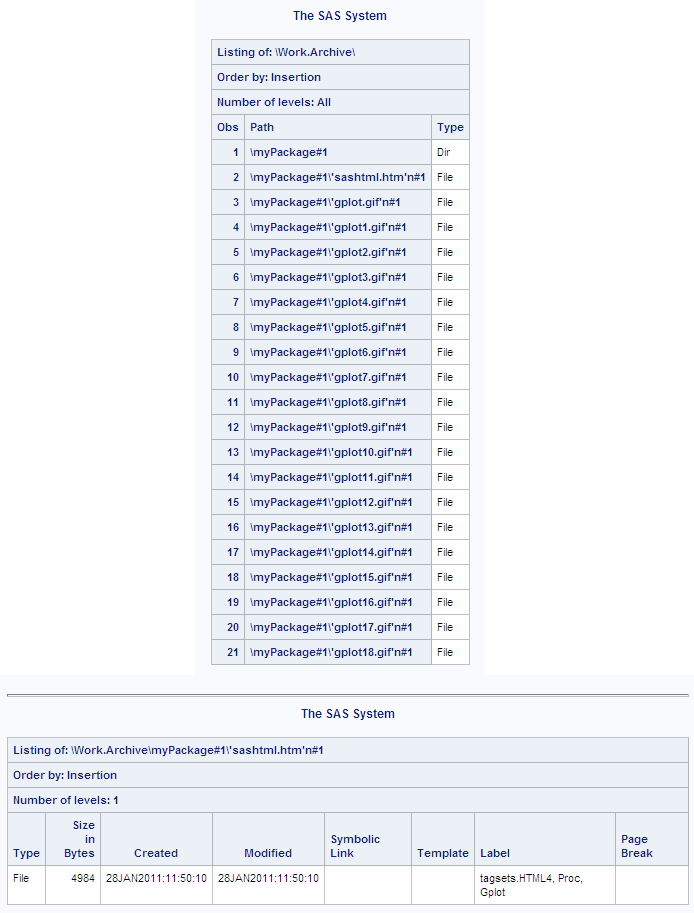ODS PACKAGE Statement
The ODS PACKAGE statement opens, adds to, publishes,
or closes one SAS Output Delivery System (ODS) package object.
| Valid in: | Anywhere |
| Category: | Data Access |
| Requirement: | The destination must specify the PACKAGE option to connect with the package. |
| See: | ODS packages are used primarily with the Publishing Framework. For complete information about the Publishing Framework feature of SAS Integration Technologies, see SAS Publishing Framework: Developer's Guide. |
Syntax
Required Arguments
- ADD
-
adds a file or data set to an ODS package using the specified Multipurpose Internet Mail Extensions (MIME) type.Requirement:When using the ADD argument, you must also use the MIMETYPE=, FILE=, or DATA= arguments to specify a file or data set and a MIME type.
- FILE="file-specification" <TEXT | BINARY>
-
specifies the file that you want to add to an ODS package.
- file-specification
-
specifies one of the following:
Default:If you do not specify the TEXT or BINARY values, then the file is added as binary, unless it is a text file. Text files are added as text by default.Restrictions:You can use the FILE= argument only with the ADD argument.You cannot add a file and a data set to an ODS package.
Example:Use the following statement to add the Test.SAS file as plain text to the ODS package directory SAS:ods package add file="test.sas" mimetype="text/plain" path="sas/";
- DATA=member-specification
-
specifies the data set that you want to add to an ODS package. member-specification can be in the form libname.membername or membername.Restrictions:You can use the DATA= argument only with the ADD argument.
You cannot add a file and a data set to an ODS package.
- MIMETYPE=''string"
-
specifies the Multipurpose Internet Mail Extensions (MIME) type for the file or data set that you are adding to an ODS package.Restriction:You can use the MIMETYPE= argument only with the ADD argument.
- OPEN EXPIRATION= <'expiration-date'>
-
creates the ODS package object to which the ODS destinations can connect. The ODS package object holds the package metadata and tracks the locations of any files that are added to the package metadata.Example:The following ODS PACKAGE statement opens an unnamed package with an abstract and a description:
ods package open abstract="this is my abstract" description="this is description";
- PUBLISH EXPIRATION=<'expiration-date'>
-
builds the ODS package and sends it to the chosen delivery transport.
- CLOSE
-
deletes the package object. As long as you have not closed a package, you can publish it as many ways and times as you want.Tip:Use the CLEAR option to remove files that have been added to the package.
- transport
-
specifies the deliver transport to use with the PUBLISH action. transport can be one of the following:
- ARCHIVE PROPERTIES(transport-property-1="value-1"… transport-property-n="value-n"")
-
publishes a package to an archive. For a list of transport properties and their values, see the section on transport properties in the SAS Publishing Framework: Developer's Guide.Example:The following statement publishes an ODS package to the archive Test.spk:
ods package publish archive properties(archive_path="./" archive_name="test.spk");
- EMAIL PROPERTIES(transport-property-1="value-1" . . . transport-property-n="value-n") ADDRESSES("e-mail-address-1" . . . "e-mail-address-n")
-
publishes a package to one or more e-mail addresses. For a list of transport properties and their values, see the section on transport properties in the SAS Publishing Framework: Developer's Guide.Example:The following statement publishes an ODS package to the e-mail addresses your.email@company.com and your.second.email@company.com:
ods package publish email addresses("your.email@company.com" "your.second.email@company.com") properties(archive_name="testPackage" archive_path="./");
- QUEUE PROPERTIES(transport-property-1="value-1" . . . transport-property-n="value-n") QUEUES("queue-1" . . . "queue-n")
-
publishes a package to one or more message queues. For a list of transport properties and their values, see the section on transport properties in the SAS Publishing Framework: Developer's Guide.
- SUBSCRIBERS PROPERTIES(transport-property-1="value-1" . . . transport-property-n="value-n")
-
publishes a package to subscribers who are associated with the specified channel. For a list of transport properties and their values, see the section on transport properties in the SAS Publishing Framework: Developer's Guide.
Optional Arguments
- ABSTRACT=string
-
specifies a string for the abstract metadata of the package or file.Restriction:You can use the ABSTRACT= option only with the ADD or OPEN arguments.
- CLEAR
-
specifies that all files that were automatically added to the package will be removed from the location to which ODS wrote them.Restriction:You can use the CLEAR option only with the CLOSE argument.
- DESCRIPTION=string
-
specifies a string for the description metadata for the package or file.Restriction:You can use the DESCRIPTION= option only with the ADD or OPEN arguments.
- <(name)>
-
specifies the name of a package. Naming a package enables you to open more than one package at a time. Each destination can connect with any package by specifying the package name in the same way.Restriction:The NAMEVALUE= option can be used only with the OPEN argument.Requirements:You must place name directly after the PACKAGE keyword in the ODS PACKAGE statement.
name must be enclosed in parentheses.
- NAMEVALUE="<name-1="value-1" . . . name-n="value-n">"
-
specifies a string of name/value pairs for the name/value metadata on the package or file.Restriction:The NAMEVALUE= option can be used only with the ADD or OPEN arguments.
- PATH="path-specification"
-
places the file or data set at the specified pathname within an ODS package.Restriction:You can use the PATH= option only with the ADD argument.Example:Use the following statement to add the Test.SAS file as plain text to the ODS package directory SAS:
ods package add file="test.sas" mimetype="text/plain" path="sas/";
Details
A package is a container
for digital content that is generated or collected for delivery to
a consumer. ODS packages allow ODS destinations to use the SAS Publishing
Framework. An ODS package is an object that contains output files
and data sets that are associated with any open ODS destinations.
ODS packages hold the package metadata and track the output from
any active destinations that connect to it. After the destinations
are closed, the package can be published to any of the publish destinations.
You can continue to use the package, or you can close it. A package
remains active until explicitly closed.
Examples
Example 1: Creating an ODS Package
The following example
creates a simple ODS package. The package is created in your default
directory, if you do not specify a different directory.
Program
goptions dev=gif xpixels=480 ypixels=320;
ods package open; ods html package;
proc gplot data=sashelp.class;
plot height*weight;
by name;
run;
quit;
ods html close;
ods package publish archive properties
(archive_name="SimpleExample.zip" archive_path="./");
ods package close;
ods html;Program Description
Open an ODS package and specify that HTML output be added
to the package. The ODS PACKAGE statement
opens an ODS package with no name. The PACKAGE option specified by
the ODS HTML statement specifies that output from the HTML destination
be added to the package.
Example 2: Listing Package Contents with the ODS DOCUMENT Statement
In the following program,
PROC DOCUMENT imports the archive SimpleExample.zip into a PROC DOCUMENT
package named myPackage.You can then use PROC DOCUMENT to list the
contents and details of the package.
Program
proc document name=archive; import archive="SimpleExample.zip" to myPackage; list/levels=all; run;
dir myPackage; list 'sashtml.htm'n/details; run; quit;
Program Description
Create an ODS document and import SimpleExample.zip.The DOCUMENT procedure creates the ODS document Archive.
The IMPORT TO statement imports SimpleExample.zip into the package
myPackage. The LIST statement lists all of the levels of Archive.

